The lost Egyptian origins of the superstitious numbers 13 and 18
Top image: The Great Pyramid, south side.
The superstitious numbers 13 and 18 both have a long history reaching back millennia. The first is usually regarded as unlucky, the latter, lucky – but why? What are the actual origins of these unusual numbers, and why do they carry such diverse connotations? Let us delve into the ancient beginnings of these magical numbers, and discover their real royal pedigrees.
Transformative Thirteen
“13 is the most enigmatic of all numbers, as it is the number of transformation. ” (Pythagoras).
When thirteen falls on a Friday, millions of people around the world are genuinely fearful, most buildings skip the thirteenth floor, and nobody wants to be the thirteenth guest invited to a dinner, lest they die before the year is finished. This is due in large part to Christian influence in the Western World. According to the Gospels, Judas Iscariot was the thirteenth guest at the Last Supper , the guest who ultimately betrayed his master.
 Judas retiring from The Last Supper, painting by Carl Bloch, 1834-1890.
Judas retiring from The Last Supper, painting by Carl Bloch, 1834-1890.
On Friday, October 13, 1307, King Philip IV of France ordered the arrest of the Knights Templars , most of whom ultimately died. Christianity also downplayed the importance of this number because of its association with pagan religion (for example, there should be thirteen witches in a coven, etc). Interestingly, there is a Norse story in which the god Loki was 13th to arrive at a feast in Valhalla, where he tricked another attendee into killing the god Baldur.
Thirteen is also the death card in the tarot deck, but far from a negative sign, the card usually means a major change in a person’s life. “It is uncommon that this card actually represents a physical death, rather it typically implies an end, possibly of a relationship or interest, and therefore an increased sense of self-awareness.” (Eden Gray, The Complete Guide to the Tarot, 1970).
According to numerologists, the number 13 is considered to be very karmic, associated with the divine, and is believed to bring good luck and prosperity to those who embrace it. In fact, many people believe that the number 13 brings about change, which can often lead to a positive outlook. A good example of this is Taylor Swift, who is arguably the most successful female music artist in history. 13 is her lucky number. “I was born on the 13th. I turned 13 on Friday the 13th. My first album went gold in 13 weeks. My first #1 song had a 13-second intro,” the singer told MTV in an interview.
New Beginnings of 13
The idea of thirteen being a number of change, of transformation, seems to come from its place following twelve, which has long been seen in ancient cultures as representing completeness, perfection, entirety and even cosmic order. There are two twelve-hour periods in a day, twelve lunar months in the solar year, twelve Olympian gods , Twelve Labors of Hercules, twelve sons of Jacob, twelve tribes of Israel , twelve disciples of Jesus, and even the twelve days of Christmas. However, hiding behind the so-called “complete” number twelve is the number representing “un”-completeness, or something new, something just beginning: thirteen.
The concept of new beginnings associated with thirteen is also prevalent in Judaism, which doesn’t see thirteen as an unlucky number, but rather as an important number representing new beginnings and luck. Jewish children become full adults at age 13 (at the Bar/Bat Mitzvah ), responsible for obeying all Jewish laws ( mitzvoth). When Israel was established in 1948, its first provisional government had thirteen members because its founders said they “needed all the luck they could get”.
Further important Jewish uses of this number include: the 13 Attributes of Hashem/Mercy- שלושה עשר מידיא (in Exodus 34:6-7), the 13 Jewish Principles of Faith according to Maimonides, and the number of days of Festivals in a year in the diaspora. Also, Adar II (or the 13th month in a leap year) is considered extra lucky because the month of Adar according to tradition is a “lucky month”.
Luck and New Life in Egypt
Thirteen was also considered lucky in Egypt. According to Kathy Padden:
“The Ancient Egyptians believed life was a spiritual journey that unfolded in stages. They believed that 12 of those stages occurred in this life, but the last, the 13th, was a joyous transformative ascension to an eternal afterlife. So the number 13 represented death to the Egyptians, but not death as in decay and fear, but as acknowledgement of a glorious eternal life.”
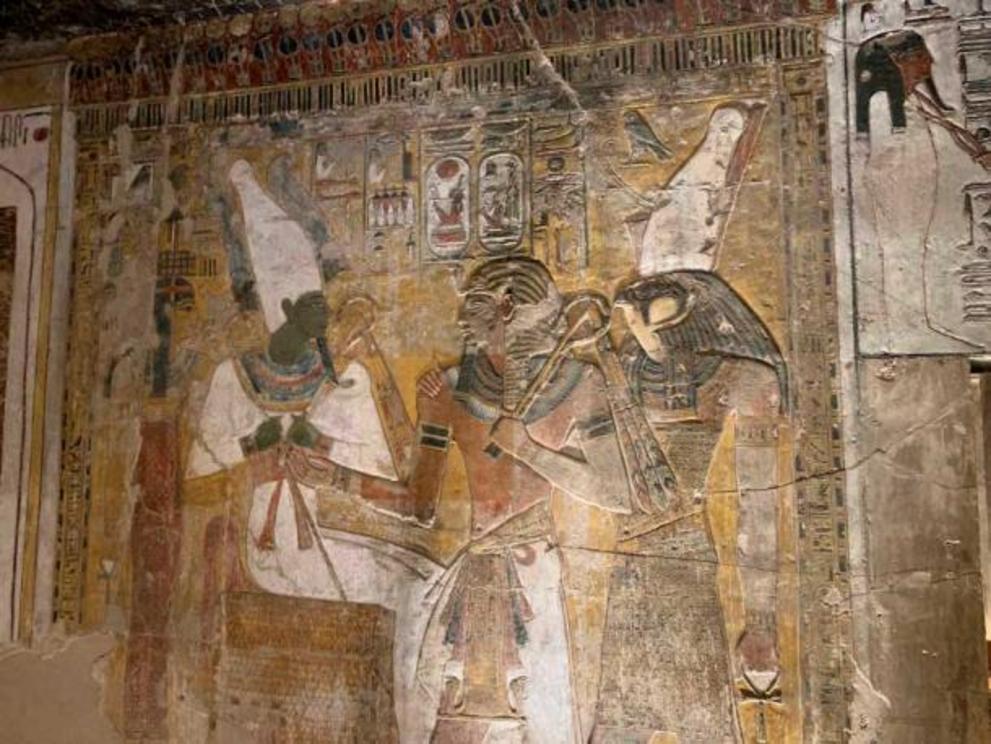 Pharaoh Seti I meets Osiris, in a scene from his tomb, KV 17, in the Valley of the Kings, Thebes, Egypt.
Pharaoh Seti I meets Osiris, in a scene from his tomb, KV 17, in the Valley of the Kings, Thebes, Egypt.
In Egyptian mythology, the deceased soul had to pass through twelve gates in the afterlife before it could arrive at the thirteenth realm, that of Osiris, ruler of the afterlife and Egypt’s first mythic Pharaoh. Here the soul was judged before Osiris and the 42 gods, and the heart was weighed against a feather of truth. Mark Oliver from Ancient Origins explains what happened to a pure soul:
“The innocent were reunited with the part of the soul left behind in the body. They would be granted eternal life and passage into paradise, where they would live with the gods in a land where the fields grew in an endless abundance.”
The number thirteen is thus associated with Osiris and the resurrection of the dead (just like the Death card, ironically).
Osiris first appears in the Pyramid Texts - mortuary inscriptions from the Old Kingdom’s 5th Dynasty, (2465-2325 BC). He appears as the first pharaoh of Egypt, and the first king to be resurrected from the dead to live eternally. In the Osiris myth , Set kills his brother, the king, and cuts his body into fourteen pieces, which he scatters across Egypt.
His sister Isis hunts far and wide and ultimately finds thirteen of the grizzly pieces. Sadly, she never ends up finding the last piece - his penis - which is eaten by a fish in the Nile. She decides to sever her own thumb to use as a phallus for her brother, and binds together his pieces using linen wrappings, creating the world’s first “mummy”. After reciting magical spells, Osiris is magically resurrected, becoming the archetype of all future resurrections. He ultimately becomes God of the Duat, Judge of the Dead, and Lord of the Afterlife. Additionally, Isis takes the form of a bird and impregnates herself on Osiris, creating Horus, who ultimately avenges his father and kills his uncle.
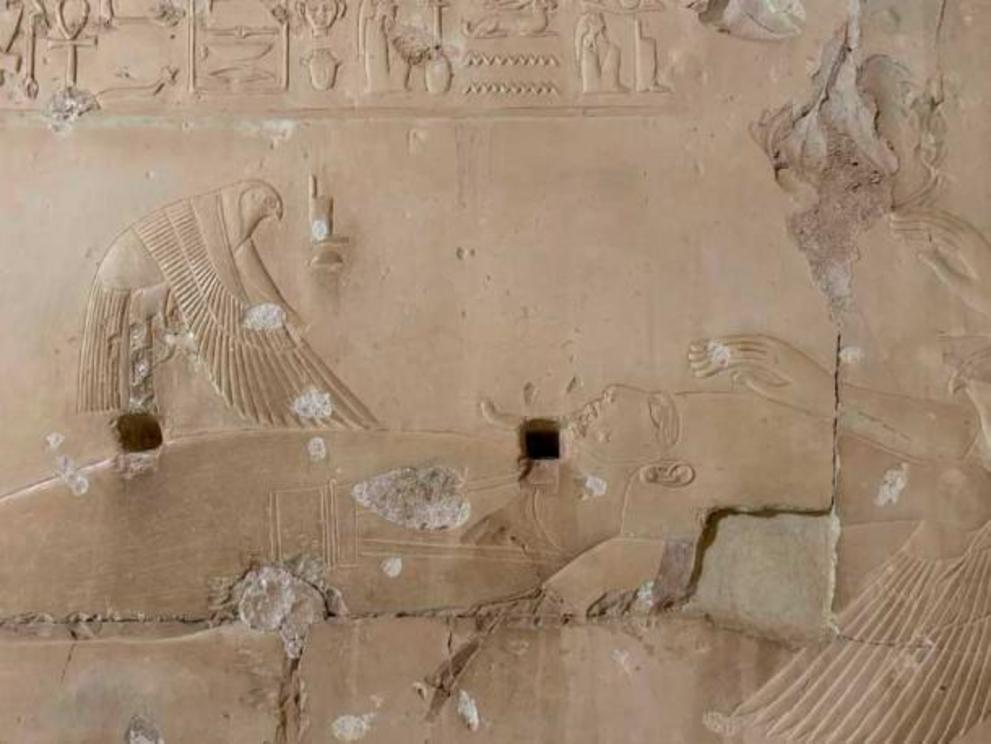 Detail of Osiris from the Temple of Seti I at Abydos. Isis lands on his penis in the form of a bird, to impregnate herself with Horus. According to the myth, the reassembled and resurrected body of Osiris only had thirteen original pieces, because the fou
Detail of Osiris from the Temple of Seti I at Abydos. Isis lands on his penis in the form of a bird, to impregnate herself with Horus. According to the myth, the reassembled and resurrected body of Osiris only had thirteen original pieces, because the fou
Osiris was the god with which Pharaohs “fused” when they died – to live eternally both in the stars and the Fields of Aaru. For example, in the Osiris complex of the Medinet Habu mortuary temple of Ramses III at Luxor, we see an image of the Pharaoh as Osiris in the afterlife, holding the crook and flail, demonstrating “his revival and coronation in the realm of Osiris, Chief of the Westerners and Ruler of Eternity, the god par excellence of the dead” (Bill Murnane).
Thus, thirteen is a number steeped in ancient myth, representing the resurrection of Osiris, his realm of eternity reached by the pure soul after twelve gates (or hours) of darkness and demons, and ultimately of personal transformation.
Esoteric Eighteen
The number eighteen has long been a famously lucky number in Judaism. Donations are often given in its multiples, such as 36 and 72, as an expression of blessing for long life. The reason usually given for this luckiness is that the Hebrew word for “life”, chai (חי), has a numerical value of 18 (as all words in Hebrew also have a numerical equivalent). Thus, gifts and money are given in multiples of 18 because Jews believe it encourages long life.
The main prayer of the Jewish liturgy is called the Shemoneh Esrei (“eighteen”) and is recited by observant Jews thrice daily. It dates back at least two thousand years, and recounts eighteen requests for God, such as asking God to help grant wisdom and understanding. It is also known as the Amidah, and today includes a final nineteenth blessing, asking God for peace, goodness, blessings, kindness and compassion. We thus know eighteen has been a popular number in Judaism for expressing a wish for a long life.
The question remains: why?
The word chai, or “life”, likely derives from the ancient Egyptian word hai, which translates as “rejoicing”. For example, the famous Pharaoh Amenhotep III built himself a palace on the West Bank at Thebes and called it the Per Hai, or the “House of Rejoicing”. There must have been great jubilation and excitement in this illustrious palace, which has been partially excavated. According to Arielle P. Kozloff:
“The name was no understatement, judging from the superabundant potsherd gift labels found there, many inscribed with year dates.”
The Prince of Egypt, the soon-to-be monotheistic Pharaoh Akhenaten, eventually built his own Per Hai at his new city of Akhet-Aten (modern Amarna).
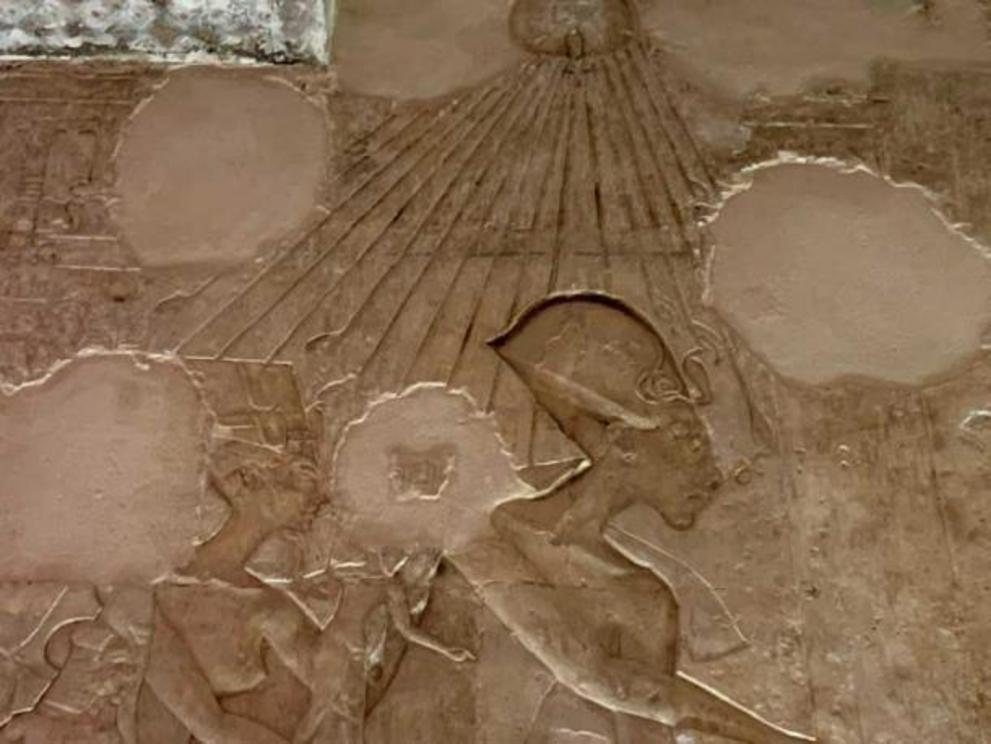 A depiction of Akhenaten, Nefertiti, and their young daughters, from the Tomb of Aye, #25, Amarna, Egypt. Do you notice the ankh sign for “life” being bestowed on the king’s nostrils by the loving hands of the Aten sun disk? An embrace of life (as the kin
A depiction of Akhenaten, Nefertiti, and their young daughters, from the Tomb of Aye, #25, Amarna, Egypt. Do you notice the ankh sign for “life” being bestowed on the king’s nostrils by the loving hands of the Aten sun disk? An embrace of life (as the kin
Eighteen to Life
This evidence is further supported by a peculiar fascination of these Pharaohs with the ankh, the well-known symbol of life in ancient Egypt. This was especially loved by Akhenaten, who constantly depicted himself being given the gift of life by his sole god, the Aten sun disk. Life to these pharaohs was all important, and numerous hieroglyphic inscriptions grant a long life to Pharaoh, in a very Jewish sense: “Long live the Good God, who is pleased with Truth, Lord of all the Aten encircles, Lord of Heaven, Lord of Earth, and Great Living Aten who illuminates the Two Banks. Long live the Father, the Aten, given life forever continually - Great Living Aten …” (Inscription from the Tomb of Ay, #25, Amarna).
The author has written previously that Akhenaten was intent on becoming a new Osiris - “Akhenaten upended centuries of tradition in all areas of Egyptian life, and depicted himself as a “new Osiris”, an Osiris “of the day” - personally offering his people sebayt, ma’at, and ankh: “the way, the truth, and the life”. Contrary to Osiris being the source of all new growth, under his new paradigm and according to Amarna inscriptions, this quality had been transferred to the Aten. We read in the Great Hymn to the Aten from the tomb of Ay, the king’s general:
“You (Aten) who rise and make all creation grow for the king … You (Aten) make the inundation from the underworld … as for all distant countries, you make their life… how functional are your plans, O Lord of Continuity! ” (Lord of Continuity was a title of Osiris).
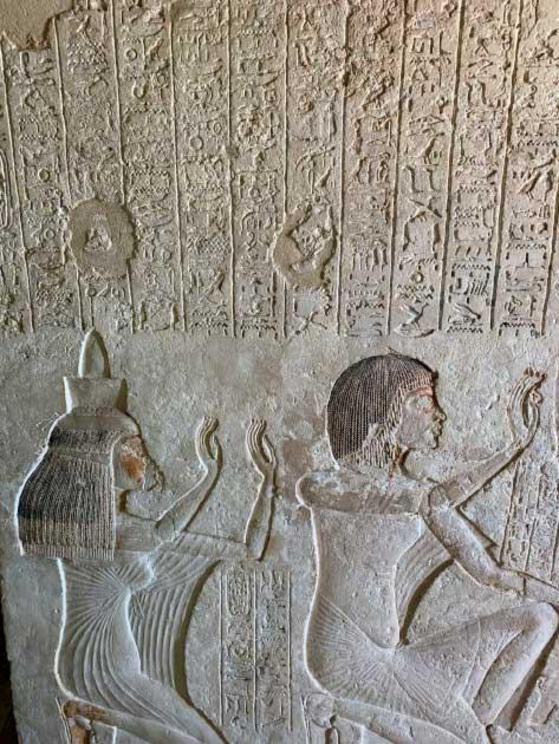 A depiction of Aye and his wife Tey, above which is inscribed the famous Hymn to the Aten. Tomb of Aye, #25, Amarna, Egypt. In this ground-breaking hymn, written by Akhenaten, the Aten assumes the role previously held in Egyptian myth by Osiris: “You (Ate
A depiction of Aye and his wife Tey, above which is inscribed the famous Hymn to the Aten. Tomb of Aye, #25, Amarna, Egypt. In this ground-breaking hymn, written by Akhenaten, the Aten assumes the role previously held in Egyptian myth by Osiris: “You (Ate
If Akhenaten, who envisioned himself as a new Osiris, lived on to become Moses, as this author has argued, we can better understand his emphasis on long life, one living God, and rejoicing - all aspects of the famous lawgiver. For example, Akhenaten was often described in contemporary texts as promulgating a moral-ethical, commandment-based Teaching of life , nearly identical to the Torah of Moses ( “How prosperous is he who hears your Teaching of Life, for he will be fulfilled …” Tomb of Ay).
Torah meanwhile has been described as a teaching for all life, and, using remarkably Amarna-esque language: “The goal of Jewish life is to embody Torah, the living word of the living God addressed to all creation through the life and experience of Am Yisrael, the Jewish people.” (Rabbi Lewis Eron).
Eighteen Enemies of Egypt
The number eighteen represented Egypt’s enemies, at least in an allegorical sense. The first line of the famous Merneptah Stele reads: “Year 5, third month of the third season (eleventh month), third day, under the majesty of Horus: Mighty Bull, Rejoicing in Truth; King of Upper and Lower Egypt: Binre-Meriamon, Son of Re: Merneptah-Hotephirma, magnifying might, exalting victorious sword of Horus, Mighty Bull, smiter of the Nine Bows , whose name is given forever and ever.”
Likewise, the Sphinx Stele of Amenhotep II provides a striking textual description of Pharaoh smiting his enemies: "He bound the heads of the Nine Bows... He has gathered them all into his fist, his mace has crashed upon their heads..."
According to Jimmy Dunn: “The figure “nine” represented three times three, which was the “plurality of Pluralities”, thus designating the entirety of all enemies.” This is curiously echoed in the Psalms of the Old Testament. For example, Psalm 110:1 reads: “… until I make your enemies your footstool.” Amazingly, a footstool with depictions of these enemies was found by Carter in the tomb of Tutankhamun.
Also found within the famous tomb were sandals with depictions of the nine bows on each foot, making a total of eighteen enemies of Pharaoh (eight bows were drawn on the sandals, while the strap represented the ninth and final bow). Ancient Origins contributor Cecilia Bogaard notes :
“What’s even more surprising is the depiction of bound enemies on more than one pair of sandals included within King Tut’s tomb … the inner soles of a pair of elaborate marquetry veneer sandals depict an African prisoner on one sandal and an Asiatic prisoner on the other, representing the enemies of King Tut’s kingdom. Taking into account that artistic representations were used to manifest reality in ancient Egypt, the message was quite clear. Every time the pharaoh took a step, he would have literally been stepping on the faces of his enemies.”
Tutankhamun literally walked on his eighteen enemies daily, reminding the world that Pharaoh, despite his youth, ruled all.
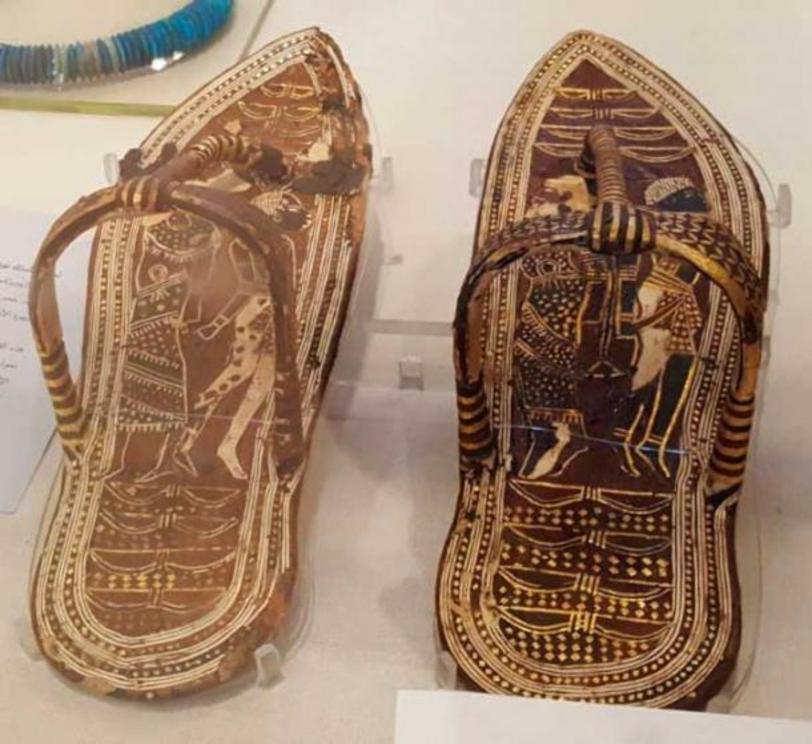 Sandals of Tutankhamun, showing foreigners alongside eight bows, with the ninth bow being represented by the sandal strap itself. Thus, the king walked on eighteen symbolic enemies. Now in the Egyptian Museum, Cairo.
Sandals of Tutankhamun, showing foreigners alongside eight bows, with the ninth bow being represented by the sandal strap itself. Thus, the king walked on eighteen symbolic enemies. Now in the Egyptian Museum, Cairo.
Eighteen in Art and Architecture
Ever since the Old Kingdom, almost 5,000 years ago, the human figure has been depicted in art using grid squares. For example, when a wall was about to be painted, the artists “began by covering the wall with a grid, enabling them to copy faithfully from a design drawn up on papyrus. They then traced the outline of the figures in red paint …human figures had a standard number of squares.” (Strudwick, 2006). This happened to be eighteen grid-squares from foot to eye-level (thus allowing for any-sized headdress).
Eighteen was thus the magic number to depict all gods and people in the Egyptian art canon for thousands of years.
Upon what were these eighteen squares based? Well, it was the human “palm”, or four fingers (the famous “royal cubit” was equal to seven palms, or just under 21”). These eighteen squares were divided into eleven squares from feet to waist (actually 11.1 from feet to navel, very important to the Egyptians), and seven squares from waist to eye-level. They are also in a golden ratio (Φ) with each other (18:11.1 is an excellent approximation of Φ). Two quantities are in the “golden ratio” if their ratio is the same as the ratio of their sum to the larger of the two quantities, or 1.618. It has long been recognized in geometry and nature, and has been used in art due to its aesthetic pleasantness.
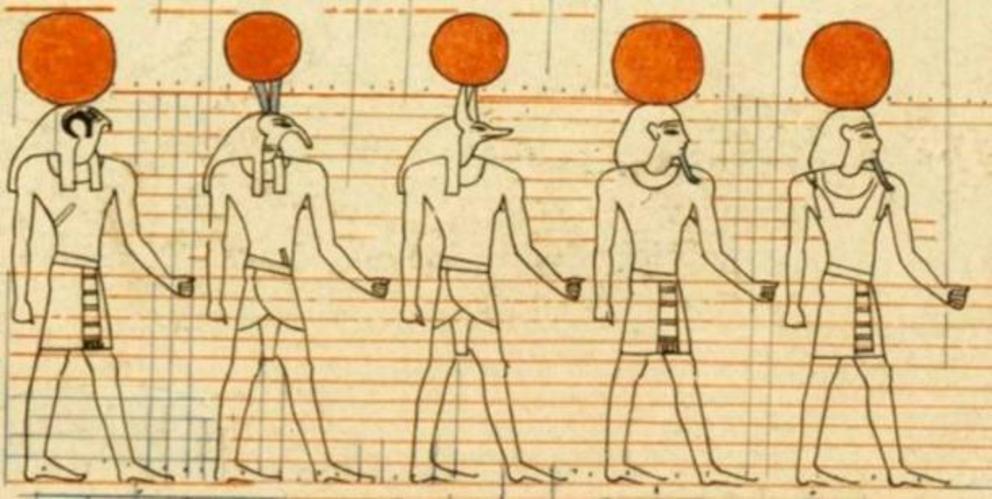 A detail of the Astronomical Ceiling, Tomb of Senenmut (TT 353), facsimile drawing by Charles Wilkinson, now in the MET, New York. The ceiling is unfinished, and the grid for body proportions is still visible overlain on the gods.
A detail of the Astronomical Ceiling, Tomb of Senenmut (TT 353), facsimile drawing by Charles Wilkinson, now in the MET, New York. The ceiling is unfinished, and the grid for body proportions is still visible overlain on the gods.
Looking deeper, researcher Christopher Bartlett believes these numbers are present within the dimensions of the great Pyramid itself. For example, its base to height ratio is 11:7, exactly the same ratio as the human body.
“The Egyptians had a predilection for simple golden ratio proportions in their art and architecture. Since the figural formula they employed gave a primary golden ratio division of 7:11, then it follows that if the same human proportion was used for the design of the Great Pyramid the golden ratio would appear as its consequence rather than its cause.”
There are further examples of this ratio within the massive structure. Rudolf Gantenbrink, using his small robot Upuaut, discovered in 1997 several 14:11 and 11:7 proportions in the interior measures and in the horizontal exit points of the pyramid shafts. For example, they are placed at a 14:11 division of the vertical height, creating an angle of 51.843°, the same as the side of the pyramid. Further, the shafts meet at a point at the base of the King’s Chamber that is 11:18 of the horizontal distance between the outer openings of the two shafts.
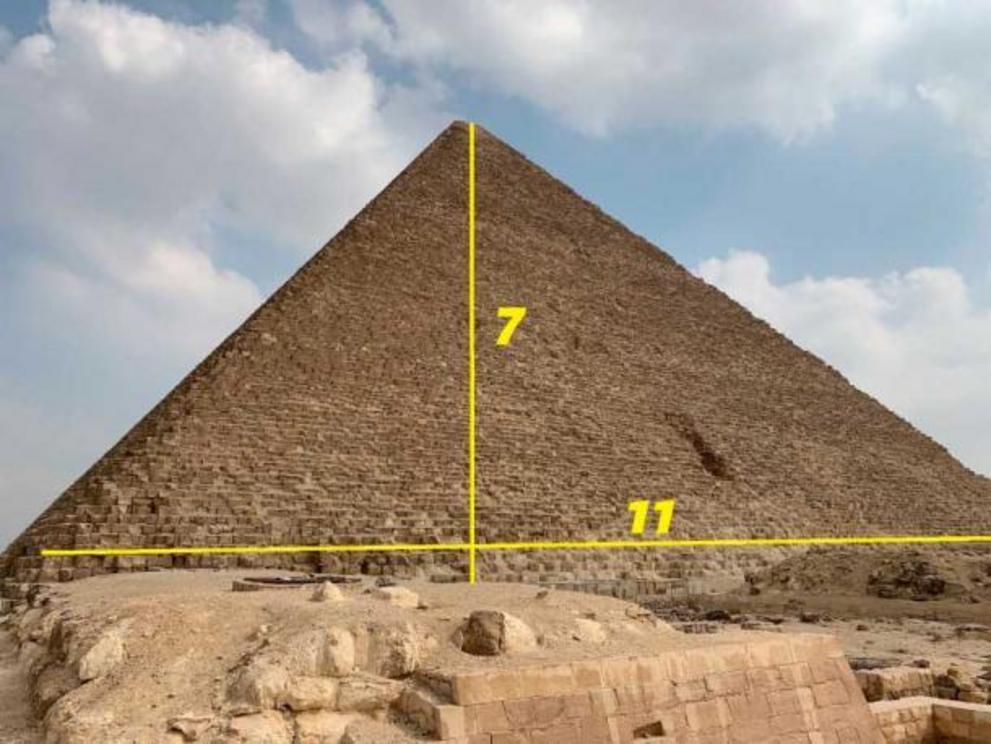 The Great Pyramid, south face. The Great Pyramid incorporated the numbers seven, eleven, fourteen and eighteen, as well as pi and the Golden Ratio.
The Great Pyramid, south face. The Great Pyramid incorporated the numbers seven, eleven, fourteen and eighteen, as well as pi and the Golden Ratio.
Bartlett notes that previous studies, such as Badawy’s in 1965, have identified evidence of the simple golden ratio proportion (1:1.6) applied to at least 55 Egyptian temples. Meanwhile, R.A. Schwaller de Lubicz demonstrated in his 1998 book The Temple of Man that Luxor Temple utilized the golden ratio and the aesthetic proportions of the human figure; and its architectural plan corresponded to vital anatomical parts of the body, such as the navel corresponding to the Peristyle “Sun” Court of Amenhotep III.
Thus eighteen is perhaps the most important number in defining the proportions of people and gods and even the grandest pyramids from five thousand years ago, as well as a long life well lived. Thirteen meanwhile challenges us to accept new things in life, to become like Osiris and transform ourselves with divine help. (Interestingly, Akhenaten ruled his new city Amarna for thirteen years).
The next time you see a thirteen or an eighteen, consider it lucky. You are syncing with a special secret symbolism that stretches back millennia, and tapping into the same sacred numbers that built the Pyramids, the same symmetry that defined ancient art and beauty, and the same powers of resurrection harnessed by the very gods and pharaohs of Egypt.
For full references please use source link below.

